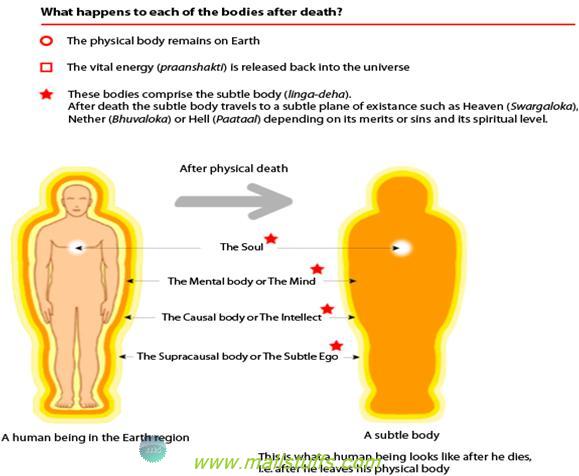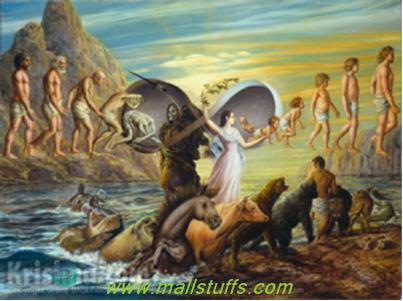
Scientific explanation of Hindu cosmology and reincarnation
In this article Who created universe, God or Big bang ?, we saw that all humans, animals, plants and entire universe is nothing but the energies of Lord Brahma who himself is the energy of the supreme god, which known by different names like Allah, Jesus, Vishnu etc. In this post, we will learn why living beings die and what happens after death?
This article is explained beautifully in hindi and english in the below videos on youtube.
There are many humans who rejects the existence of The Creator and believe only in science and data gathered or confirmed by its canonical methods. But, on any given day, the same person might find himself in love, deep remorse or sadness. And while contriving the most complex and personal thoughts, he does not, at the time, suppose that his feelings are a random product of firing neurons. How can he then believe that the only distinction between a corpse and a living person is the absence of organ functionality? That we need only revive his physical body to restore him to normality?
If this is the case then all humans died by heart attack cane be made alive again, by making their heart organ start functioning again?
A great sage explains the inability of science to do it in this way: if the creator wants that a particular individual has to die, then no one will be able to save him and if the creator wants that a particular individual has to live then even after his death, he will come back alive again. This current technology like organ transplantation, complex surgical operations is nothing but the will of the gods where he might want to save some of his creations(Humans) but before saving , he want this individual to have a death like experience for his bad karma.
Now let us see what science says about death?
According to science, when the person dies, kinetic energy inside the body is converted into potential energy and stays with the body. This energy is then converted to other forms of energy depending upon the decomposition process or body burning process.
In every human activity, energy is continuously released by the body into the atmosphere. For example, in breathing also, energy is released from the body continuously. So, I find it difficult to believe that all kinetic energy produced by the body, stays inside the body after death and nothing is released into the atmosphere. Although this is a possibility but I find the answers written in Hinduism religious scriptures more convincing since it gives more detailed explanations.
According to Hinduism religious scriptures, when a person dies, some invisible form of energy is released from the body immediately. This energy is called as soul (atma).
So what happens with this released energy (soul?)
There are three possibilities depending upon the karma of the soul.
1) If the soul has done enough good karma and are eligible for liberation and salvation (Moksha), then this soul travels across the universe and unites with the supreme soul i.e. Energy release by supreme god in form of soul returns back to him.
Note that soul is called as ‘atma’ is Sanskrit and supreme soul is called as parmatma in Sanskrit. Another meaning of ‘parmatma’ is supreme god
2) If the karma of the soul is not good enough for salvation (Moksha), then this soul travels across the universe in search of a new body. This soul will get the new body according to the karma done by his previous body. I.e. if the soul has done very good deeds like donation, charity, helping poor’s etc then he will be born in the womb of the mother belonging to the rich and well-honored respected family and if the soul has done bad deeds like cheating, murder, rape etc then he will be born in an illiterate , poor and low-caste family.
3) According to lord Krishna, at the time of death, person realizes the ultimate truth. So, whatever the person sees at the time just before his death, he will become the same in his next life. So, if the person thinks about god, then he will either become demi-god or will unite with the supreme god. If he thinks of eating delicious tasty meat, then he will be born as a carnivorous animal. If he thinks of some alien type creature, then he will be born in a planet where such alien creature exists and so on.

The Scientific Theory of Evolution - Charles Darwin Theory
Charles Darwin is famous worldwide for his evolutionary theory. According to his theory, one species evolved into another. Thus one body changes into another. We evolved from the animals, our closet relatives in the animal kingdom are the monkeys.
The Vedic Theory of Evolution
The Vedic scriptures also state an evolutionary process, but the definition is different from that of Charles Darwin. There are 8.4 million different species of living beings in the whole of creation as follows:
900,000 species of aquatic.
2,000,000 species of plants.
1,100,000 species of insects.
1,000,000 species of birds.
3,000,000 species of beasts.
400,000 species of human beings
All these species were created by God and like Charles Darwin’s theory; we also evolved from the animals but not by changing the same body, but by transmigration of the soul from one body to another.
Changing bodies from birth to death, and the evolution of 8,400,000 species.
Transmigration of The Soul From One Body To The Next
 Every living being is a soul (including plants and animals) covered in a material body. The soul takes one body then quits it to take another and so on. Going through all the various species in the plant and animal kingdom (8 million) and then finally taking a human body. The human body is the highest and most elevated of all bodies.
Every living being is a soul (including plants and animals) covered in a material body. The soul takes one body then quits it to take another and so on. Going through all the various species in the plant and animal kingdom (8 million) and then finally taking a human body. The human body is the highest and most elevated of all bodies.
Once we attain the human body, if we misuse or fail to utilize the higher consciousness then we again fall down in the plant and animal kingdom. Then again we have to go through the evolutionary process, moving from one body to the next in the plant and animal kingdom for 8 million births before we get another human birth.
“As the embodied soul continuously passes, in the body from childhood to youth to old age, the soul similarly passes into another body at death. A sober person is not bewildered by such a change.” Lord Krishna (Bg. 2.13)
“As a person puts on new garments, giving up old ones, the soul similarly accepts new material bodies, giving up the old and useless ones.” Lord Krishna (Bg. 2.22)
This is just a small explanation.You can find whole detailed explanation about life after death, according to Vedas, in the following article.
What Happens To Us After Death
After reading Vedas, even the greatest scientist like Albert Einstein didn’t deny this possibility and applauded bhagvad gita for its value-based teaching.
If you are still not convinced then go through the following articles too:
Living under the illsuon of lord vishnu-part 1
Living under the illsuon of lord vishnu-part 2
Following are the versus from bhagavad gita on soul and reincarnation
Chapter 2, verse 13
dehino'smin yatha deha kaumaram yauvanam jara
tatha dehantara praptir dhiras tatra na muhyati
Translation
Just as in the physical body of the embodied being is the process of childhood, youth, old age; similarly in the transmigration from one body to another the wise are never deluded.
Chapter 2, verse 17
avinasi tu tad viddhi yena sarvam idam tatam
vinasam avyayasasya na kascit kartum arhati
Translation
But know that by whom the entire physical body is pervaded is indestructible. No one is able to cause the destruction of the imperishable soul.
Chapter 2, verse 20
na jayate mriyate va kadacin nayam bhutva bhavita va na bhuyah
ajo nityah sasvato yam purano na hanyate hanyamane
Translation
The soul never takes birth and never dies at any time nor does it come into being again when the body is created. The soul is birthless, eternal, imperishable and timeless and is never terminated when the body is terminated.
Chapter 2, verse 22
vasamsi jirnani yatha vihaya navani grhnati naro'parani
tatha sarirani vihaya jirnany anyani samyati navani dehi
Translation
As a person gives up old and worn out garments and accepts new apparel, similarly the embodied soul giving up old and worn out bodies verily accepts new bodies.
Chapter 2, verse 24
acchedyo'yam adahyo'yam akledya'sosya eva ca
nityah sarva-gatah sthanur acalo'yam sanatanah
Translation
The soul is indestructible, the soul is incombustible, insoluble and unwitherable. The soul is eternal, all pervasive, unmodifiable, immovable and primordial.
Chapter 2, verse 27
jatasya hi dhruvo mrtyur dhruvam janma mrtasya ca
tasmad apariharye'rthe na tvam socitum arhasi
Translation
For one who has taken birth, death is certain and for one who has died, birth is certain. Therefore in an inevitable situation understanding should prevail.
In this last verse the cycle of life is clearly revealed. From birth comes death and from death comes birth. Just like in the spring new buds grow which blossom into flowers and leaves in summer and in autumn change to red, yellow and orange in fall and blow away and become dormant in winter to begin the process all over again in the following year. In the a similar way the soul enters new bodies for its seasons of infancy, youth, maturity and old age and at the end of its cycle of life is born again accepting a new body for another season. This is an inevitable process in the material existence and is the automatic process that governs the birth and death. All beings existing in the material manifestation completely follow this reality.
Below are some of the quotes about soul and reincarnation from major Hinduism religious scriptures:
Bhagavad-gita (7.5) describes that above these eight material elements (air, water, fire etc) is soul which is superior to them:
"Besides these [eight], O mighty-armed Arjuna, there is another, superior energy of Mine, which comprises the living entities who are exploiting the resources of this material, inferior nature."
"For the soul there is neither birth nor death. It has not come into being, does not come into being, and will not come into being. It is unborn, eternal, ever-existing and primeval. It is not slain when the body is slain. As a person puts on new garments, giving up old ones, the soul similarly accepts new material bodies, giving up the old and useless ones. The soul can never be cut to pieces by any weapon, nor burned by fire, nor moistened by water, nor withered by the wind. This individual soul is unbreakable and insoluble, and can be neither burned nor dried. He is everlasting; present everywhere, unchangeable, immovable and eternally the same. It is said that the soul is invisible, inconceivable and immutable. Knowing this, you should not grieve for the body."- Bhagavad-gita (2.20-25)
When one dies in the mode of goodness, he attains to the pure, higher planets of the great sages. When one dies in the mode of passion, he takes birth among those engaged in fruitive activities; and when one dies in the mode of ignorance; he takes birth in the animal kingdom. Bhagavad-gita (14.14, 15)
The living entity in the material world carries his different conceptions of life from one body to another as the air carries aromas. Thus he takes one kind of body and again quits it to take another. The living entity, thus taking another gross body, obtains a certain type of ear, eye, tongue, nose, and sense of touch, which are grouped about the mind. He thus enjoys a particular set of sense objects. Bhagavad-Gita (15.8-9)
As the embodied soul continuously passes in this body, from boyhood to youth to old age, the soul similarly passes into another body at death. A sober person is not bewildered by such a change. (Bhagavad-Gita. 2.13)
The foolish cannot understand how a living entity can quit his body, nor can they understand what sort of body he enjoys under the spell of the modes of nature. But one whose eyes are trained in knowledge can see all this. (Bhagavad-Gita. 15.10)
For example, the Mundaka Upanishad (3.1.9) explains that the living being is the soul, and that: “The soul is atomic in size and can be perceived by perfect intelligence. This atomic soul is situated within the heart, and spreads its influence all over the body of the embodied living entities. When the soul is purified from the contamination of the five kinds of material air, its spiritual influence is exhibited.”
The Chandogya Upanishad (6.11.3) also states that although the body withers and dies when the self or soul leaves it, the living self does not die.
Further enlightenment is given in theSrimad-Bhagavatam (7.2.22) wherein it explains that the spirit soul has no death and is eternal and inexhaustible. He is completely different from the material body, but because of being misled by misuse of his slight independence, he is obliged to accept subtle and gross bodies created by the material energy and thus be subjected to so-called material happiness and distress.
So, the body dwindles and dies but the soul does not die: it simply changes bodies. Therefore, the body is like a shirt or coat that we wear for some time, and when it is worn out, we change it for a new one.
Chandogya Upanishad (8.1.1), mentions that knowledge of the self within is what should be sought and understood by all. Realizing one’s spiritual identity solves the problems and mysteries of life.
Do not burn him entirely, Agni, or engulf him in your flames. Do not consume his skin or his flesh. When you have cooked him perfectly, only then send him forth to the fathers (Rig Veda 10.16. 1) 2~
This hymn expresses the desire and hope that, after the purification through fire, Agni, the dead person receives his body back, made perfect, so as to enjoy the life of the fathers.
Other hymns speak to the dead man, of the final dispersal of his old body:
May your eye go to the sun, your life's breath to the wind? Go to the sky or to earth, as is your nature; or go to the waters, if that is your fate. Take root in the plants with your limbs (Rig Veda 10. 16.3).22
Another hymn addresses the dead:
Creep away to this broad, vast earth, the mother that is kind and gentle.
And to the earth:
Open up, earth; do not crush him. Be easy for him to enter and to burrow. . Earth, wrap him up as a mother wraps a son in the edge of her skirt (Rig Veda 10.18.10-l l) 23
Brihadaranyaka Upanishad. "A man becomes good by good works, evil by evil' (3. 2.13) and on death, like a caterpillar -or a grass leech - proceeding from one leaf to another, the soul (atman), having shaken off the body and freed itself from ignorance, presumably empirical life, makes a beginning on another body.
As a goldsmith forms newer and fairer form from a rough nugget, so the soul fashions for itself another newer, fairer form (4. 4.4), whether it be of the Fathers, or the Gandharvas, or the gods, or Prajapati, or Brahman, or other living beings; just as man acts, just as he behaves, so will he be born. He who does well will be born good, he who does evil will be born evil: he becomes holy by holy deeds, evil by evil (Brahadaranyaka Upanishad 4. 4.2-6; 4. 3 33).

Thus, Reincarnation actually makes a lot of sense as a theory of continuous life and death. If consciousness is an energy, then it cannot just disappear when we die. The body dies, but that conscious energy has to go somewhere, may be into a new body or merge with the consciousness of the god. That�s the law of conservation of energy.
We are more than physical bodies operating according to the laws of physics and chemistry. We, the conscious self (Atma), are inherently connected to the greater whole (ParamAtma), and this eternal inherent connection is totally transcendental to matter. All living entities (Atmas), having free will, to either ignore this connection or to recognize it, thus attaining liberation or repeating the cycle of birth and death
Note: Images used on this website
are either a production of Bhaktivedanta Book Trust(https://www.krishna.com), Iskcon
Foundation or were found in google search under "Free to use and share". If any
of the images presented here violates copyright issues or infringes anyone copyright
or are not under "Fair use", then please bring it to our notice. Read
Disclaimer for more.
Share this to your friends. One of your friend is
waiting for your share.
Related Articles
Vedas Quotes Against Present Caste System
Fall and Rise of river saraswati-India most sacred river
Science in hinduism-Embryology in Garbhopanishad and Charaka samhita
Common questions and myths of caste system
Do plants sing or create music
Should software professionals practice spirituality
Science in Hinduism-Invention of numeral system
Why number 108 is holy and auspicious in Hinduism
Rama Sethu-Proof of India great ancient science
Do plants feel pain or sufferings
Post Comment